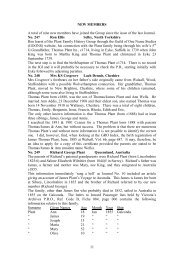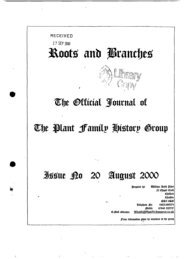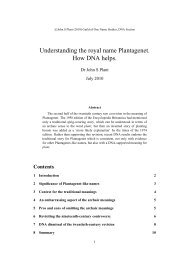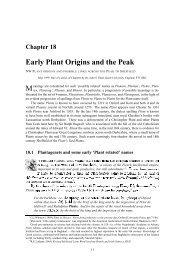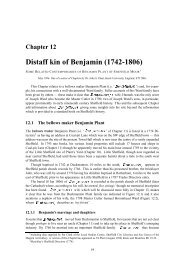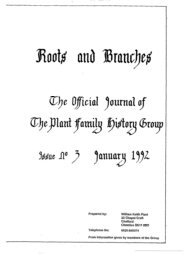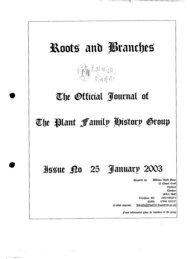Chapter 34 Austin Plant - Plant Family History Group
Chapter 34 Austin Plant - Plant Family History Group
Chapter 34 Austin Plant - Plant Family History Group
Create successful ePaper yourself
Turn your PDF publications into a flip-book with our unique Google optimized e-Paper software.
<strong>34</strong>.2. AUSTIN’S FIRST BATTLE 31<br />
4. Poperinghe in Belgium is mentioned in <strong>Austin</strong>’s notes of 17 Oct 16 and 6-23 Aug 17; it is<br />
about 7 miles W of Ypres. Poison gas (chlorine) had been used for the first time successfully<br />
in war by the Germans at Ypres on 22 Apr 15 and mustard gas was used in 1917. <strong>Austin</strong> was<br />
killed on 10 Oct 17 at Hooge, which is on the Menin Road running eastward from Ypres, just<br />
north of the strategic high ridge that formed the southern flank of the eastwards advance into<br />
Passchendaele.<br />
<strong>34</strong>.2 <strong>Austin</strong>’s first Battle<br />
The Battle of Loos 1 , which began 25 Sep 15, was part of the first major offensive for some of<br />
Kitchener’s New Army division. Haig was to assault on a seven-mile front between Loos and<br />
La Bassée. This was flat country covered in industrial workings, predominantly mines and their<br />
slag heaps. There were several heavily protected villages protected by deep belts of barbed wire;<br />
this was country the Germans would find easy to defend. Six divisions, some 75,000 men, were<br />
in the opening attack following a four day bombardment and the first British use of poison gas.<br />
Cavalry were to exploit the breakthrough. However, torrential rain the night before slowed the<br />
battalions’ arrivals. In the morning the rain stopped and the breeze dropped but gas from 1,500<br />
cylinders were still used. The attack was at 6:30 a.m. At the north end, the gas was blown back<br />
into British lines and the attack failed. At the south end, the gas was blown into the German lines,<br />
and German trenches and Loos town were taken; but the success could not be exploited quickly as<br />
three Divisions of reserves were held 5 miles behind the front lines, which were many hours of hard<br />
slog away through the heavy rain of the next night; and the reserves were not in place by the next<br />
morning, so the Germans counter-attacked and succeeded. Seven Victoria Crosses were earned on<br />
the first day. By mid-October, the battle petered out – 15,800 men were killed or missing, <strong>34</strong>,580<br />
wounded. The line had advanced 2 miles at the most. The village of Hulluch and Hill 70 were still<br />
in German hands.<br />
<strong>34</strong>.3 <strong>Austin</strong>’s final Battles<br />
In 1917 there were serious mutinies in the French army and, to relieve the situation, Haig ordered an<br />
all-out attack with a stated eventual (phase 3) objective of cutting the German U-Boat rail transport<br />
link at Bruges, which is about 35 miles NE of Ypres. The ensuing Battles of Ypres in 1917 is often<br />
called ‘Wipers 3’ for there had been earlier battles in 1914 and 1915. Wipers 3 barely succeeded as<br />
far as the phase 1 objective of capturing Passchendaele only 6 miles NE of Ypres. The campaign<br />
was eventually described by Lloyd George as:-<br />
the battle which, with the Somme and Verdun, will always rank as the most gigantic,<br />
tenacious, grim, futile and bloody fight ever waged in the history of war<br />
In the initial action a ‘gigantic system’ (4 miles) of mines was exploded just beneath the German<br />
front line at 03:10am on 7 Jun 17; the explosion was heard in England. This marked the start<br />
of the Battle of Messines (7-14 Jun), after which there was a slow British advance until 31 Jul<br />
when ‘Wipers 3’ proper began with advances to the east by about 2 miles along a 12 mile front,<br />
taking the action by 4 Oct to within about 1 mile of Passchendaele whereafter the campaign came<br />
almost to a standstill in costly and bitter fighting in the swamps around Passchendaele; the intricate<br />
drainage system of the low ground around Ypres had been shattered by the long bombardment and<br />
the consequent overflow of streams, swollen by heavy rain, turned much of the battle area into a<br />
bog.<br />
1 R. van Emden (2005) Boy Soldiers of the Great War.



